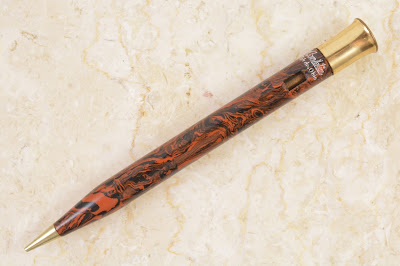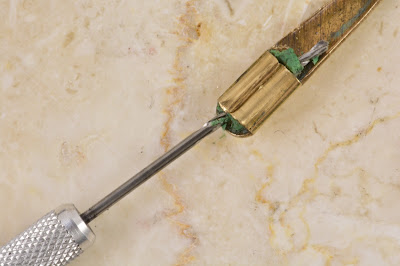This article has been edited and included in The Leadhead's Pencil Blog Volume 4; copies are available print on demand through Amazon here, and I offer an ebook version in pdf format at the Legendary Lead Company here.
If you don't want the book but you enjoy this article, please consider supporting the Blog project here.
The Catalogue on page 72. Although it hasn’t caught on, it’s held up pretty well for me - nearly all of the Skylines I’ve seen in the wild fit neatly into these classes:
From left, I referred to these as:
Skyline Standard I: striated top section, thin band
Skyline Standard II: striated top section thick band
Presentation: ribbed gold filled top section
Presentation Vertical: gold filled top, lengthwise lines
Presentation Dart: gold filled top, engine turned design
Solid I: single color/material barrel with no bands
Solid II: single color/material barrel, thin center band
Solid III: single color/material barrel, thick center band
Streamliner: simplified clip/derby assembly
Press Clip I: simple clip pressed into barrel, no bands
Press Clip II: simple clip pressed into barrel, single band
Press Clip Twist Model: twist action pencil
Press Clip Moore Patent: feature a Moore patented action (these days, I call these “Lovejoy patent Skylines”).
In fact, since the book was published, the only additions I’ve made to the above have been in the “Press Clip” series, and I haven’t added anything to that area in four years (see http://leadheadpencils.blogspot.com/2012/06/eversharp-skyline-press-clip-v.html):
From top, there’s the Press Clip I and II, augmented by the Press Clip III (single wide band), IV (no bands at all) and V (thin center band only).
Obviously I’m bringing all of this up to let you know I’ve got another one to add to the Press Clip clan, and I wonder whether I call it VI or whether I ought to leave a few numbers in between, since it feels like there should be something in between the simple single-band variations I’ve shown you so far and this one:
This one also comes from Rob Bader - with no provenance other than the “junk box provenance” of being found in the wild. Although it seems to be a one-off, I suppose I’ll give it a VI if/when there’s a second edition of The Catalogue.
From left, I referred to these as:
Skyline Standard I: striated top section, thin band
Skyline Standard II: striated top section thick band
Presentation: ribbed gold filled top section
Presentation Vertical: gold filled top, lengthwise lines
Presentation Dart: gold filled top, engine turned design
Solid I: single color/material barrel with no bands
Solid II: single color/material barrel, thin center band
Solid III: single color/material barrel, thick center band
Streamliner: simplified clip/derby assembly
Press Clip I: simple clip pressed into barrel, no bands
Press Clip II: simple clip pressed into barrel, single band
Press Clip Twist Model: twist action pencil
Press Clip Moore Patent: feature a Moore patented action (these days, I call these “Lovejoy patent Skylines”).
In fact, since the book was published, the only additions I’ve made to the above have been in the “Press Clip” series, and I haven’t added anything to that area in four years (see http://leadheadpencils.blogspot.com/2012/06/eversharp-skyline-press-clip-v.html):
From top, there’s the Press Clip I and II, augmented by the Press Clip III (single wide band), IV (no bands at all) and V (thin center band only).
Obviously I’m bringing all of this up to let you know I’ve got another one to add to the Press Clip clan, and I wonder whether I call it VI or whether I ought to leave a few numbers in between, since it feels like there should be something in between the simple single-band variations I’ve shown you so far and this one:
This one also comes from Rob Bader - with no provenance other than the “junk box provenance” of being found in the wild. Although it seems to be a one-off, I suppose I’ll give it a VI if/when there’s a second edition of The Catalogue.







































